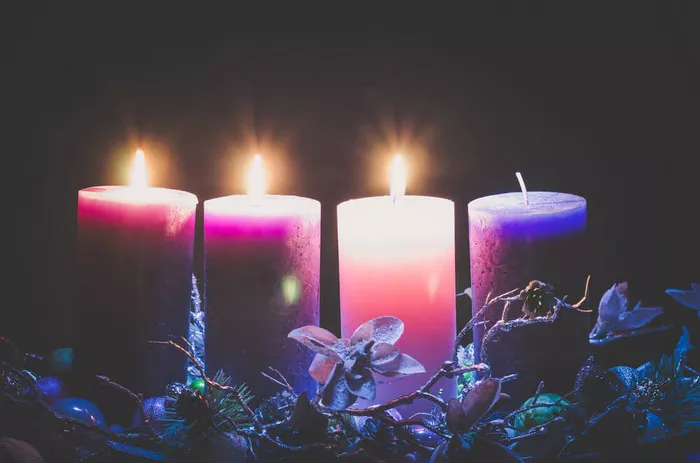As the holiday season approaches, Christian communities worldwide prepare for the celebration of Christmas through the observance of Advent. This sacred period, marked by anticipation and reflection, is symbolized by the Advent wreath and its four candles, each representing profound spiritual themes. In this comprehensive exploration, we delve into the significance of Advent candles, shedding light on their rich symbolism and spiritual significance.
Advent: Embracing the Season of Anticipation
Advent, derived from the Latin word “adventus,” meaning “coming” or “arrival,” encompasses the four weeks leading up to Christmas. Rooted in the Christian tradition, Advent serves as a time of spiritual preparation, symbolizing both the ancient longing for the Messiah’s arrival and the anticipation of Christ’s second coming. It invites believers to reflect on the profound mystery of the Incarnation and to prepare their hearts to receive the gift of Emmanuel, “God with us.”
Throughout history, Advent has been observed through various rituals and practices, including prayer, fasting, and the lighting of candles. These rituals serve as tangible reminders of the spiritual journey towards the celebration of Christ’s birth, fostering a sense of expectancy and hope among believers.
The Advent Wreath: A Symbol of Everlasting Hope
Central to the Advent observance is the symbolic imagery of the Advent wreath. Crafted from evergreen branches, arranged in a circular shape, the wreath symbolizes the eternal nature of God’s love and the unending cycle of life. The circular form of the wreath represents God’s eternity and the unbroken circle of His love, while the evergreen branches signify the enduring nature of Christ’s presence in our lives.
The four candles nestled within the wreath represent the four weeks of Advent, each carrying its own distinct symbolism and message of hope, peace, joy, and love. As the weeks progress, these candles are sequentially lit, illuminating the path towards the celebration of Christ’s birth.
The Four Advent Candles: Illuminating Spiritual Themes
1. The First Candle (Purple): Hope
The lighting of the first candle, often referred to as the “Prophet’s Candle,” symbolizes hope and expectation. It recalls the longing of ancient Israel for the coming of the Messiah and anticipates the fulfillment of God’s promise. In the midst of darkness and uncertainty, the flame of hope flickers brightly, reminding believers of God’s faithfulness and the certainty of His promises. As Isaiah prophesied, “The people walking in darkness have seen a great light; on those living in the land of deep darkness, a light has dawned” (Isaiah 9:2, NIV).
2. The Second Candle (Purple): Peace
The lighting of the second candle signifies peace, echoing the angels’ proclamation of “peace on earth” at the birth of Christ (Luke 2:14). In a world marred by conflict and strife, the message of peace proclaimed by the Prince of Peace resonates deeply, offering solace and hope to those in turmoil. As believers light this candle, they are reminded of Christ’s transformative power to reconcile hearts and bring about true peace, both individually and globally.
3. The Third Candle (Pink): Joy
As Christmas draws near, the third candle, often known as the “Shepherd’s Candle,” radiates with the warmth of joy. Symbolizing the joyous anticipation of Christ’s birth, it reflects the exuberant response of the shepherds who received the angelic proclamation of the Savior’s arrival with great joy (Luke 2:10). In the midst of life’s challenges and uncertainties, the message of joy proclaimed by the birth of Christ offers comfort and reassurance, reminding believers of the abiding presence of God’s love.
4. The Fourth Candle (Purple): Love
The lighting of the fourth candle, known as the “Angel’s Candle” or the “Candle of Love,” encapsulates the profound truth of God’s boundless love manifested in the person of Jesus Christ. As believers prepare to celebrate the miracle of the Incarnation, they are reminded of the sacrificial love that compelled God to enter into human history, offering redemption and reconciliation to a broken world. In the words of the apostle John, “This is how God showed his love among us: He sent his one and only Son into the world that we might live through him” (1 John 4:9, NIV).
The Christ Candle: Embracing the Light of the World
At the culmination of the Advent season, on Christmas Eve or Christmas Day, a fifth candle, typically white, is lit in the center of the wreath—the Christ Candle. Symbolizing the arrival of Jesus, the Light of the World, this candle serves as a focal point for the celebration of Christ’s birth. As its flame illuminates the darkness, it reminds believers of the transformative power of Christ’s presence in their lives and the hope He brings to a world in need of redemption.
Variations and Traditions: Embracing Diversity in Worship
While the symbolism of the Advent candles remains consistent across Christian traditions, variations in candle colors, names, and interpretations may exist among different denominations or cultural contexts. Some traditions incorporate a blue candle to represent hope, while others use a white candle to symbolize purity. Similarly, the order in which the candles are lit may vary, reflecting the unique theological emphases of different faith communities.
Regardless of these variations, the underlying message of hope, peace, joy, and love remains constant, serving as a unifying thread that binds believers together in their anticipation of Christ’s coming.
Conclusion
As we journey through the season of Advent, the symbolism of the candles serves as a poignant reminder of the timeless truths of the Christian faith. In the flickering flame of each candle, we encounter the enduring hope, profound peace, exuberant joy, and boundless love found in Christ alone. As we prepare to celebrate the miracle of the Incarnation, may the light of the Advent candles guide us on our spiritual journey, illuminating the path towards the manger where God’s greatest gift awaits us.

